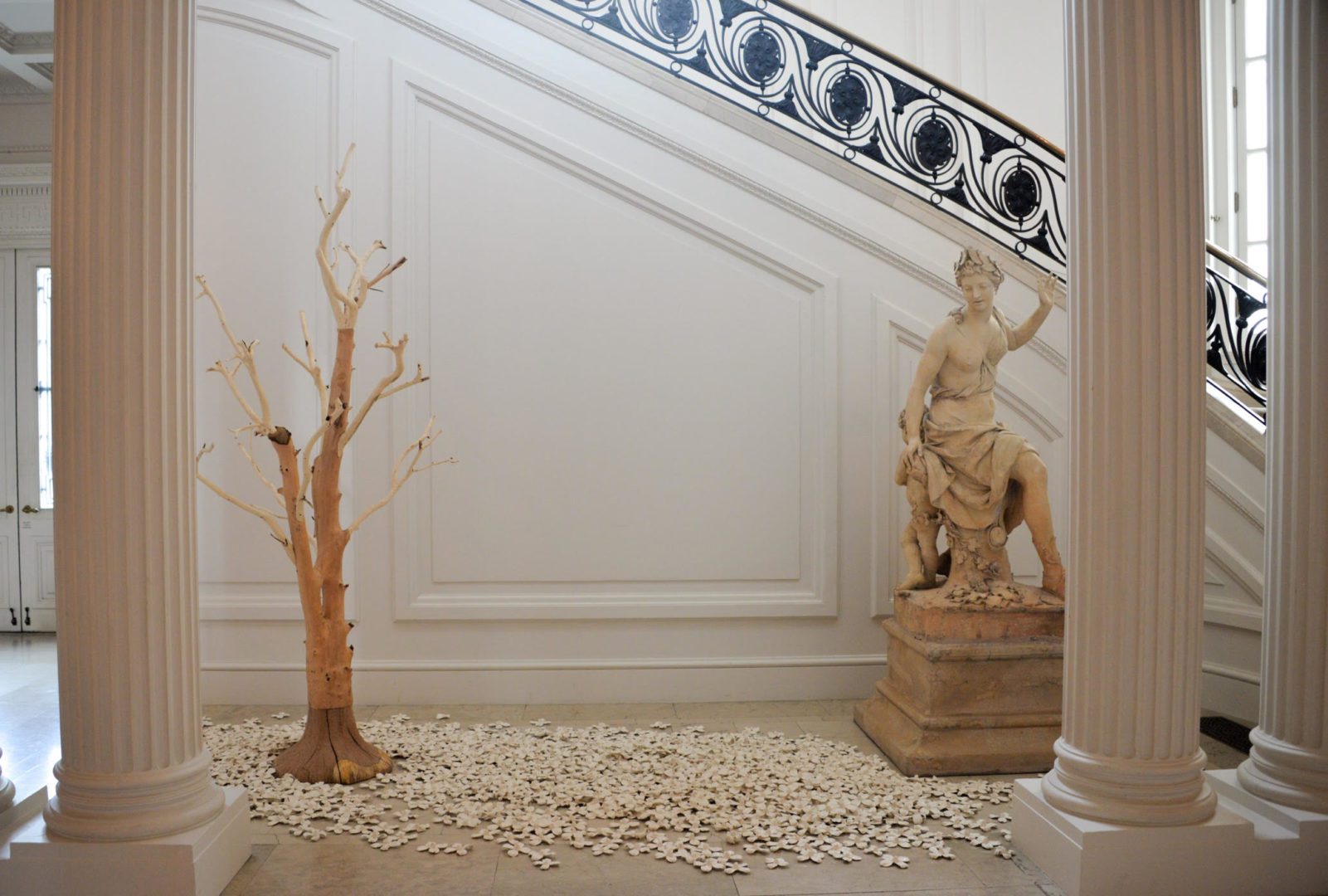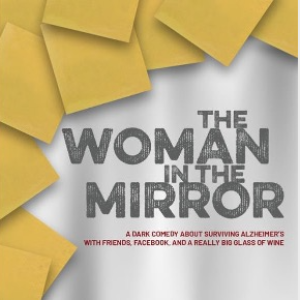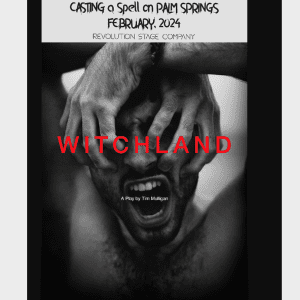 View Winners →
View Winners → 
Visitors to The Huntington Library, Art Museum, and Botanical Gardens will be delighted to see nature-inspired sculptures created by a contemporary artist intermingling with classical 18th-century pieces at the main gallery.
Three site-specific sculptures which will be on display for two years – Nest (on the loggia), Komorebi, and Thousand Blossoms (inside the gallery) – are the works of Japanese-born California artist, and former Los Angeles resident, Mineo Mizuno. Long known for his ceramic art, he started working with wood seven years ago when he and his wife Minako (who’s also an artist and owns mm project art gallery in Hiroshima, Japan) moved to the Sierra Nevada Mountains.
Mizuno and Minako, who collaborated with him on this show, graciously show us the artworks and talk about how this installation at the Huntington came about.
“In 2020, I had a show at a gallery in Beverly Hills and some of The Huntington trustees told Christina Nielsen (Hannah and Russel Kully Director of the Art Museum) about it,” Mizuno recalls. “She went and liked what she saw, so she asked to meet with me. She was originally interested in purchasing a piece but decided to give me my own show at The Huntington the more we talked.”
Even before Nielsen went to that exhibition, though, she was already familiar with Mizuno’s work. She reveals via email, “In fact, we have a Teardrop by Mineo (one of his signature pieces) in our permanent collection, and I walk past it on my way to the office each day. I didn’t know his work previously, but have been a big fan of his work since my first day on the job almost four years ago.”
While Nielsen chose the areas where she wanted Mizuno to create pieces for, she left it up to him to decide what to make. She states, “I never give an artist instructions. I could never conceive of the possibilities the way they do. But there is definitely conversation about what might be logistically possible!”

As if to confirm Nielsen’s statement, Mizuno says as we reach the loggia, “This idea came about when I saw this space. I call this Nest but there are actually two of them in one artwork. The thought behind it is that you build your home with the things around you, much like birds do. They’re made from manzanita shrubs that have been chopped down.”
Mizuno retrieved the shrubs to give them a new life that isn’t harmful but instead lends beauty to a space. He explains, “We don’t see manzanita shrubs in Southern California because they need an elevation of about 2,500 to 3,000 to thrive. These shrubs grow everywhere in Sierra Nevada and they’re fire hazards so they have to be constantly cut down. The wood of the shrub has interesting colors – some are light but some are dark colors like red.”
“This is the only time I’ve used a manzanita shrub,” adds Mizuno. “I usually create big wood sculptures made out of oak. California oak is protected, but where we live they’re usually cut down so I’m not using wood from live trees. I get my materials from someone who has a property that’s comprised of a 40-acre ranch and a surrounding 1,500-acre forest with all kinds of cut trees – like oak. But whether they’re manzanita shrubs or oak trees, I’m just recycling them.”
“All the pieces in the installation were built in my studio over time and assembled on site,” Mizuno explains. “I had been building the nest a few years ago and I altered it so that it can withstand the changes in temperature and weather.”
Minako offers her perspective, “While it’s a limited space physically, because it’s outdoor, I think it’s actually unlimited. The space changes every day – the look of the sky varies, there’s nature growing nearby, different people are around it. Changes have happened since we started building the nests.”
“During most of my career, I used ceramic for my sculptures,” Mizuno discloses. “After our son left for college, we moved to New York City, which was my lifelong dream. However, it didn’t work out that well… two years were long enough, and we moved to the wilderness in Northern California. Because of my environment, my life changed and, with it, my art.”

Dogwood blossoms are the themes of Mizuno’s two other pieces which are displayed inside the art gallery. He says as we reach the first artwork, “When they gave me this space everything was covered in plastic; so I couldn’t see what it looked like. But I knew these two sculptures (a tree nymph and Flora, the ancient Roman goddess of flowering plants) were here. They had planned to remove them to give me the space. But when they took the covering off and I saw the sculptures – one is sitting on an oak stump, and the other is holding a flower garland – I suggested we just move them to the side. So I decided to make a tree from the stump of a fallen oak to match the sculpture that’s already there. Then we scattered ceramic dogwood blossoms near it.”
According to Mizuno dogwood flowers signify hope and rebirth. They grow everywhere in the Sierra Nevadas just as cherry blossoms do in Japan. The ceramic cherry blossoms remind him of the origami pieces his 102-year-old mother makes.
Minako says, “We call this Komorebi, which is the Japanese word for filtered light, sunbeams seen through leaves in the forest. They’re individual ceramic pieces arranged like they fell from the tree and were scattered by the wind. The ceramic blossoms are kept in place on the floor with silicone.”
We approach the last sculpture and Mizuno points out, “This is called Thousand Blossoms and is made of 3,000 ceramic dogwood blossoms. Each blossom was hand-made then went in the kiln for firing. We took each one out for glazing then put it back in the kiln. We then used silicone to attach each piece to another.”
“We made these blossoms during the pandemic – when everyone all over the world was thinking about others, about our health, and life, ” Minako elucidates. “So each dogwood blossom represents one human being. We attached each individual blossom to another to create one piece to signify unity; we wanted to show the power of life. After they were stuck together, we put it inside a frame so we could transport it here. But one piece of dogwood blossom didn’t fit properly. When we got here, laid it on the floor, and removed the frame, some of the blossoms fell on the side. However, we decided to leave them be… people won’t know it wasn’t done on purpose.”
Not only were people who have seen it at The Huntington unaware that some ceramic dogwood blossoms accidentally fell out from one of Mizuno’s artworks, they have also been giving the most enthusiastic reviews. As Nielsen proclaims, “They exceeded my expectations, and I’m delighted to watch visitors discover them. The response has been overwhelmingly positive.”
There are times when unintended actions result in surprising consequences. Sometimes an otherwise unfortunate happenstance only adds dimension to an already beautiful piece of art. It’s almost poetic.









































































































